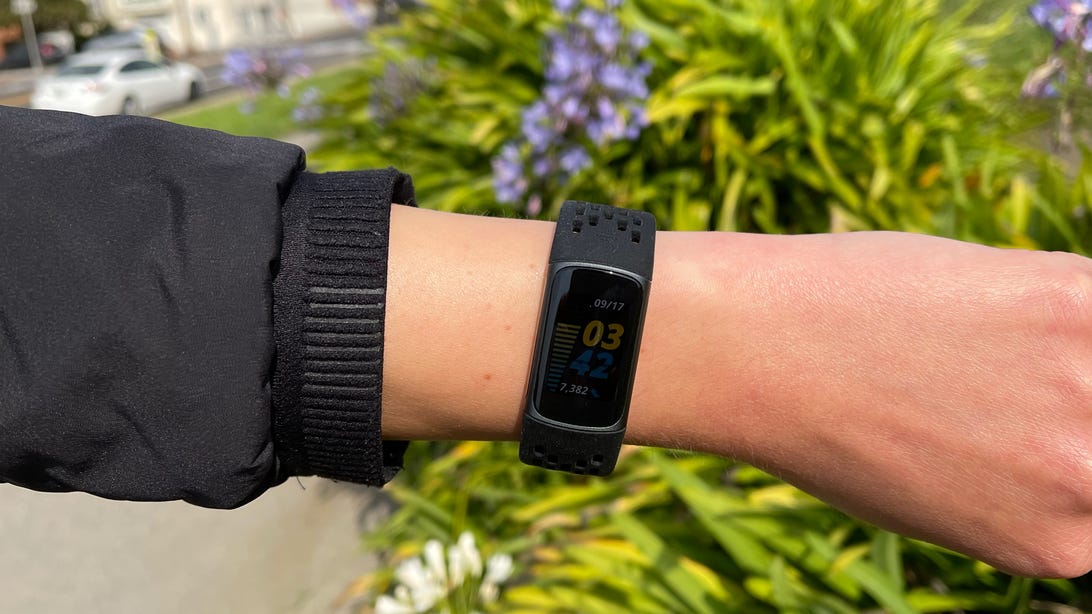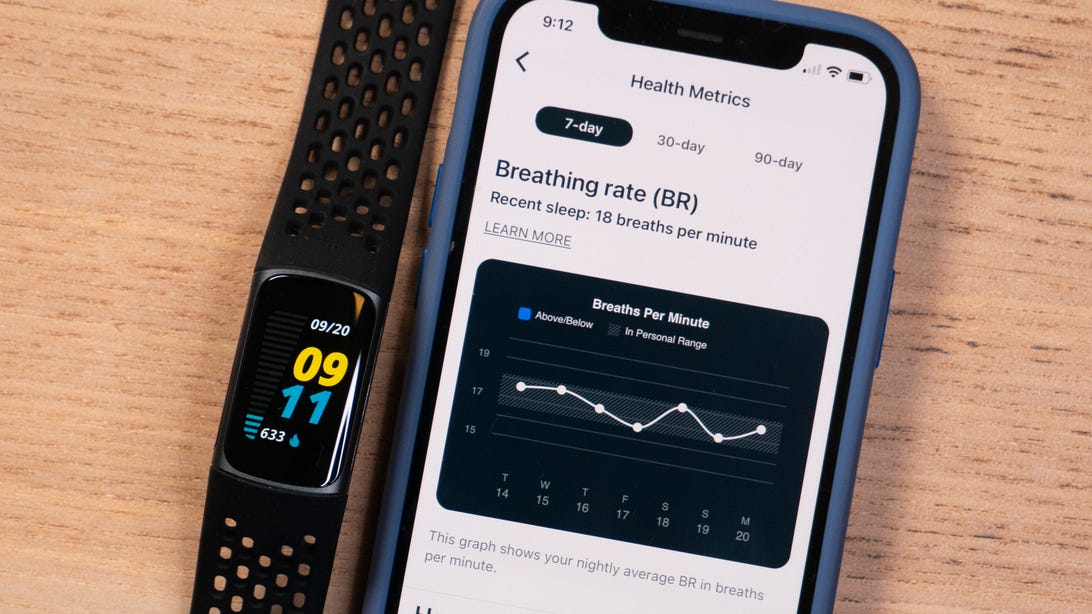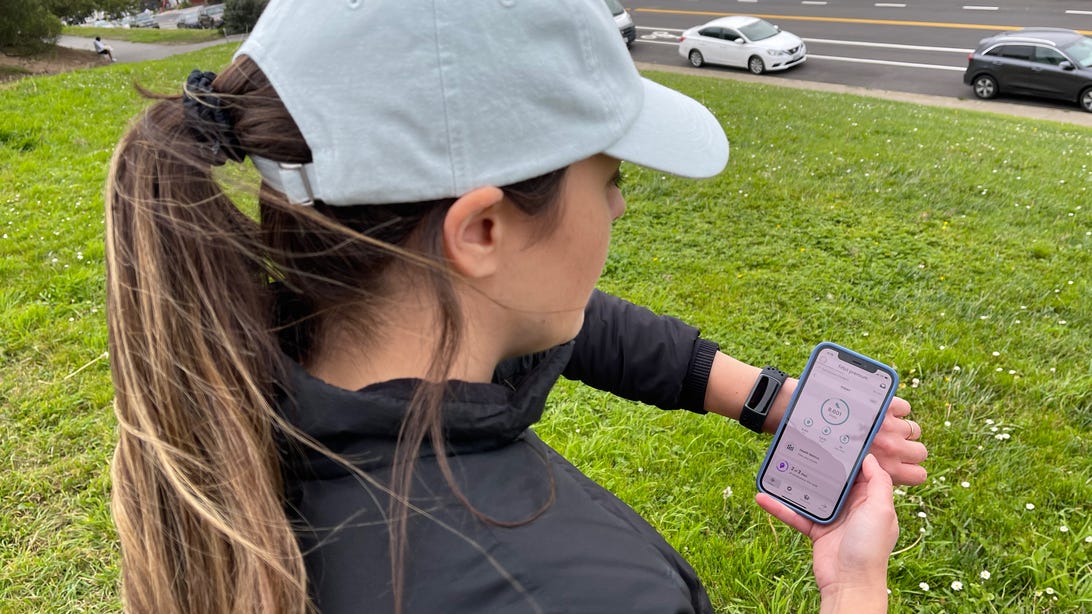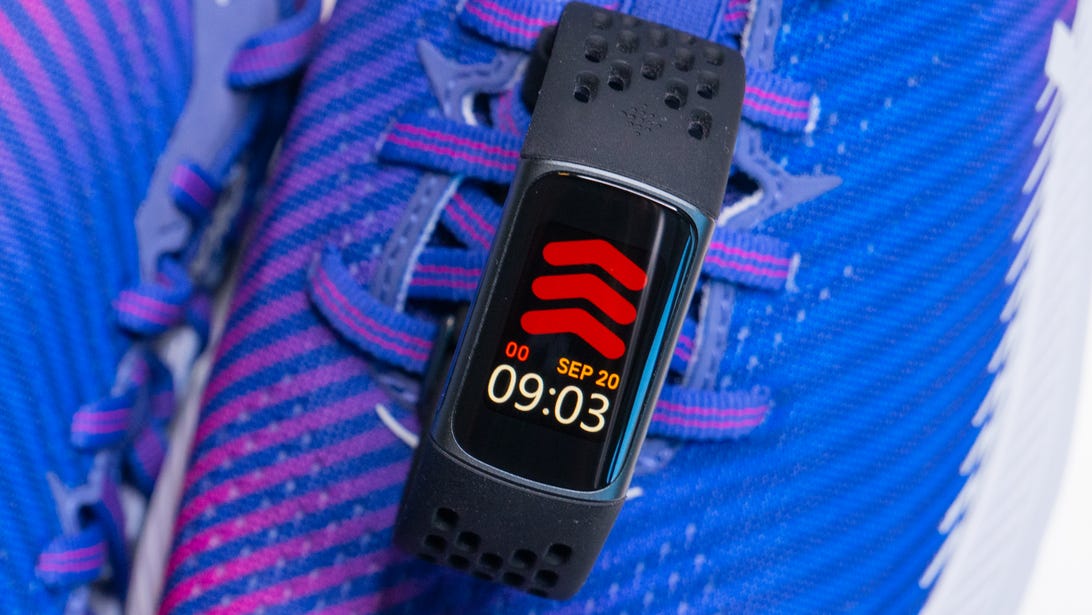The Fitbit Charge 5 is the best fitness tracker the company has made. It has almost all the same health and fitness features as Fitbit’s more expensive smartwatches like the Versa 3 and Sense for just $179 (£170, AU$270). Unless you need a larger screen, a voice assistant and music storage, the Charge 5 is hard to pass up for the price.
Like
- Bright color screen is easy to read
- High and low heart-rate alerts
- Strong sleep tracking
- Built-in GPS
Don’t Like
- Daily Readiness Score and ECG not available yet
- No altimeter for elevation tracking
- No music playback control
But there’s still one piece missing. Fitness trackers and smartwatches have offered us a wealth of data gathered from our wrists for years, but being able to interpret it is kind of a puzzle for most people. What does it mean if my heart-rate variability is high? Should I try to push myself to work out if I had a really bad night’s sleep?
Fitbit is on the precipice of being able to solve this mystery, maybe, with something called a Daily Readiness Score. The Fitbit app will tell you if you’re ready to workout with personalized activity goals, or take it slow with meditation sessions based on your metrics. Unfortunately, this feature isn’t quite ready to be rolled out, so whether or not this is actually the holy grail of recommendations remains to be seen. In the meantime, there’s enough here to wholeheartedly recommend the Charge 5 if you want a tracker with built-in GPS, an ECG, robust sleep and fitness tracking and strong battery life.
The Charge 5 is comfortable to wear 24/7
Fitbit’s given the Charge 5 a significant facelift from older models, adding a color AMOLED touchscreen and a new navigation system that’s pretty much the same idea as Fitbit’s recent slimmer tracker, Luxe, but larger. The screen offers an immediate advantage over the Charge 4, which had a monochrome display. It’s also way easier to see outdoors when the brightness is set to max. You get the option to leave the display always on, so that means no need to raise your wrist to see the time.

It doesn’t show up well in this image, but the Charge 5 screen is easy to read outdoors.
Lexy Savvides/CNET
This is also the first Charge to have no buttons whatsoever. Navigate by swiping and tapping on the screen, then swipe right or double-tap anywhere to go back to the previous screen or clock face. It might take a few tries to learn, but just having come off the back of reviewing the Fitbit Luxe, the Charge 5 is a lot easier to use because of its bigger screen. And the interface is actually pretty responsive, which is a welcome change from some earlier Fitbit trackers.
Most importantly, the text is legible and large enough so I never feel like I am squinting to see notifications, or reaching for a magnifying glass like on the Fitbit Luxe.
Heart-rate alerts, ECG and all the health metrics you could want
Even though the Charge 5 is significantly smaller than Fitbit’s smartwatches, it doesn’t skimp on sensors. Onboard is a heart rate tracker with high and low heart rate alerts; an ECG app that will be activated sometime after launch to detect signs of atrial fibrillation; an SpO2 sensor for blood oxygen levels; plus skin temperature tracking at night (but no dedicated skin temperature sensor like on the Sense).
There’s also an electrodermal activity sensor first seen on the Fitbit Sense for tracking stress. Use it by placing your fingers on either side of the Charge 5 and taking a two- to seven-minute scan. It detects minute changes in sweat, and afterward you can see how many EDA responses, or sweat-triggered incidents, you had. The idea is the more EDA responses, potentially the more stressed you are. Holding your fingers to the sides ends up feeling a little more awkward than the Sense’s method of measuring which involves holding your palm over the screen, but it also means you can see the display as you’re testing stress.
The scans create a stress management score out of 100 that also takes into account activity and sleep. Basically, the higher that score, the better your body is dealing with stress. I prefer stress tracking on the Charge 5 compared to the Sense because it’s not the main focus of the tracker. It’s just another tool you can use to help give you an idea about your overall well-being, and you can use it alongside breathing or meditation sessions in the Fitbit app to see if you can lessen your responses over time. The EDA sensor still feels more like an experiment than an essential tool, though. Technically, you don’t even need the EDA sensor to calculate a stress score, as the company’s other trackers and smartwatches can do it with the Fitbit Premium subscription service, but it does hint at how Fitbit may be positioning mindfulness efforts in the future.

A view of the health metrics dashboard in Fitbit’s app.
Lexy Savvides/CNET
Sleep tracking works in the same way as other recent Fitbit devices, and I love how much detail you get here, from sleep stages, to restlessness, to sleeping heart and breathing rates. Again, it all culminates in a sleep score out of 100 so you can see at a glance how good (or how bad) your night’s rest really was.
To get the most detailed insights from the Charge 5, you’ll need to subscribe to the $10-a-month Premium service. You do get six months free when you buy the device, but it is worth bearing in mind the ongoing cost if you want certain metrics like your sleep score breakdown and skin temperature at night, plus mindfulness sessions, workout programs and nutrition advice. Without Premium, you still get basic stats about activity, stress and sleep, plus the health metrics dashboard.
The other feature of a Premium subscription is the Daily Readiness Score. It takes into account overall activity levels, heart-rate variability and sleep quality to indicate if your body is up to being pushed on a workout, or you should take it easy and have a rest day. If it’s the former, it will also give you suggested workouts to do. In theory, it sounds similar to what Garmin offers with its body battery score, but with personalized suggestions. Unlike Fitbit, however, Garmin doesn’t charge extra for this score.
As I mentioned earlier, the readiness score won’t be available at launch and there’s no exact timeline of when Fitbit will roll it out to the Charge 5. Also somewhat confusing is your stress score and EDA readings don’t seem to contribute to the readiness score. I’m hoping that once I get the chance to test it out, more pieces of this puzzle will start to fall into place.
Same great Fitbit fitness tracking you’d expect
On top of step tracking, the Charge 5 can track over 20 different workout types from cycling to yoga, and it’s also water resistant for swimming. It can autodetect some workouts, too. There’s only room to store six activities on the Charge itself, so you can swap different workouts in and out from the Fitbit app.
Like the Charge 4, it also has GPS built-in so if you want to go without your phone on an outdoor workout, you can. Alternatively, you can set the Charge 5 to use connected GPS from your phone to save battery. It takes around 10 to 15 seconds to lock onto a signal if using built-in GPS, and in my testing it was accurate with route and distance information when compared to a control phone.
When you start an activity you can also set a goal, like duration, distance or active zone minutes: Fitbit’s way of calculating moderate to intense physical activity. The Charge 5 can also buzz when you reach different heart-rate zones, which I found pretty motivating while on a run so I knew if I was actually at my peak, or just cruising in cardio.

Checking my stats after a workout.
Lexy Savvides/CNET
Fitbit’s app is nicely laid out and it’s easy to see workout stats like your splits on a run, heart rate zones and calorie count after you sync the tracker, along with VO2 max level. Bear in mind there’s no altimeter on the Charge 5 so it will use GPS data to calculate elevation. You can’t see elevation gain in the Fitbit app either, so you’ll need to review your activity on Fitbit.com.
I did test the heart-rate sensor against a chest strap, which is considered the gold standard in consumer heart-rate tracking, and was pleasantly surprised at how well the Charge 5 matched up overall. It took two minutes for the Charge 5 to catch up to the strap’s readings at the start of every run that I did though, so hopefully a software update can address that.
Basic smart features, but maybe that’s all you need
The Charge 5 works with Android and iOS, which continues to be an advantage for Fitbit over the iOS-only Apple Watch or the currently Android-only Galaxy Watch 4. It will notify you when a call or text message comes through, and you can also choose which apps can push notifications to your wrist. Android users can send quick replies to notifications from the Charge 5, but iPhone owners can only see notifications on-wrist.
Fitbit offers a fairly limited selection of clock faces you can swap in and out of the app. Mobile payments are available with Fitbit Pay, and Google Fast Pair offers quick setup for Android phones. The Charge 5 is missing music storage, music playback control, a speaker and mic. That means you can’t take quick calls from your wrist and there’s no voice assistant. But for $179, I’m OK with Fitbit skipping those features.
There’s also no third-party apps. That’s not a deal-breaker for me considering this is a fitness tracker, not a smartwatch, but I would have liked to see a “find my phone” app to ring it within Bluetooth range. If you do want slightly more features like music playback and voice-assistant support, the Fitbit Versa 2 is still available at $179, the same price as the Charge 5 but without onboard GPS, while the newer Versa 3 that includes GPS is $230. Neither of those watches has the EDA sensor, which is otherwise in the Fitbit Sense at $300, but they can calculate a stress score.

Lexy Savvides/CNET
How long does the Fitbit Charge 5 battery last?
That will depend on how hard you push your watch and what display settings you use. For basic use, including notifications, step tracking, sleep tracking and some EDA scans, you can expect to get up to seven days with the display set to raise-to-wake. I’m a bit more of a heavy user, so when adding a daily 30-minute GPS workout to the mix I managed to get four full days.
Using the always-on display drains the battery even further, so expect to get two full days out of the Charge 5 in this scenario.
The Charge 5 is the best Fitbit for most people
For $179, the Charge 5 is a no-brainer buy if you want the best of Fitbit’s health and tracking features in an inconspicuous, band-like design. The device also comes at a formative time for Fitbit, now fully owned by Google. We still have to wait and see what’s in store for the WearOS integration between Google and Samsung. The Charge 5 does not run WearOS, and we’re waiting to see how the Fitbit apps will appear on that operating system, or if a standalone Fitbit watch running WearOS is on the way. And when Fitbit stats do show up in WearOS, will the company still make simpler fitness trackers such as the Charge 5 running Fitbit OS? Only time will tell. Until then, the Charge 5 is the best Fitbit for most people right now, including the best of Fitbit’s tracking technology at a price that’s lower than most smartwatches.
Fitbit Sense vs. Fitbit Versa 3 vs. Fitbit Charge 5
| Fitbit Sense | Fitbit Versa 3 | Fitbit Charge 5 | |
| Display size, resolution | 1.58-inch AMOLED | 1.58-inch AMOLED | 1.04-inch AMOLED |
| Always On | Yes | Yes | Yes |
| Interchangeable bands | Yes | Yes | Yes |
| GPS | Yes | Yes | Yes |
| Automatic workout detection | Yes | Yes | Yes |
| Water resistance | Yes, up to 50m | Yes, up to 50m | Yes, up to 50m |
| Notifications | Text replies (Android) | Text replies (Android) | Text replies (Android) |
| Microphone | Yes | Yes | No |
| Speaker | Yes | Yes | No |
| Voice assistant | Alexa and Google Assistant | Alexa and Google Assistant | None |
| Music | Onboard (Deezer, Pandora), playback control (Spotify) | Onboard (Deezer, Pandora), playback control (Spotify) | None |
| Mobile Payments | Fitbit Pay | Fitbit Pay | Fitbit Pay |
| Sleep tracking | Yes | Yes | Yes |
| Period tracking | Yes | Yes | Yes |
| Special features | EDA sensor, SpO2, ECG and skin temperature sensor | SpO2 and skin temperature tracking | EDA sensor, SpO2, ECG, skin temperature tracking |
| Compatibility | Android and iOS | Android and iOS | Android and iOS |
| Battery life | 6 days | 6 days | 7 days |
| Price (USD) | $329 | $229 | $179 |
| Price (GBP) | £300 | £200 | £170 |
| Price (AUD) | $500 | $400 | $279 |



:quality(80))



